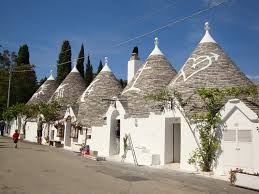Here are some of the most popular tours.
Valle D’Itria
Alberobello
In the heart of the Murgia dei Trulli, 50 kilometres (31 miles) away from Bari, a lovely spread of pinnacles announces Alberobello's characteristic historic centre UNESCO World Heritage Site. The old town centre is entirely composed of trulli, traditional drystone huts whitened with quicklime and capped by conical bare-stone roofs. The Rione Monti, a maze of narrow winding streets with over 1,000 trulli, is the oldest part of the town, along with the Rione Aia Piccola. This area is home to the Casa Pezzolla, a complex of 15 interconnected trulli that today houses the Museo del Territorio, and the Trullo Sovrano, only one trullo whit two floor. A church in Alberobello is even shaped like trulli: Sant’Antonio church, on the top of Rione Monti, boasts a Greek cross plan and a cupola 21 meters high (69 feet). Another church that is worth a visit is the Basilica Minore dei Santi Medici, patron of Alberobello.
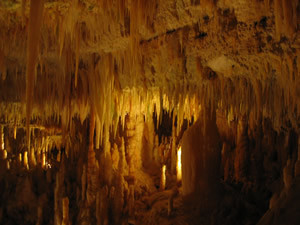 Castellana Grotte
Castellana Grotte
The world's most beautiful karst cave is the hidden treasure of Castellana Grotte, municipality in inland province of Bari, about 10 kilometers from the trulli of Alberobello and the coast of Polignano a Mare. The country derives its name, but especially the tourist vocation, his internationally famous Speleological complex, a short walk from the town.
Largo Leo the great is the heart of the old town, medieval alleys and paved yet soul from paved in local limestone. The oldest church dedicated to Pope Saint Leo, is a jewel of Romanesque architecture with sculptural furniture made from the sixteenth to the eighteenth century. Among the narrow streets of the old town, houses the Chiesa di Santa Maria del Suffragio, adorned with a skull and crossbones, wooden portal.
The image of the Patron Saint, la Madonna della Vetrana, is kept in the Church of Convento dei Frati Francescani. The protector has saved the population from plague and every year the castellanesi thank her in the Bonfire Event, 11 January, with a singular procession which leads the holy icon from the monastery to the mother church.
In Serritella, you can find Chiesa della Madonna della Grotta, example of stone architecture of the Seventeenth century.
Locorotondo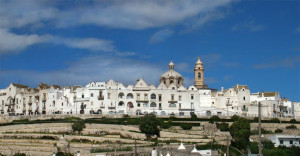
One of Italy’s Most Beautiful Towns it sits high on a plateau in the south-eastern part of the Murge dei Trulli, in the heart of Itria Valley, less than 10 km (6 miles) from Alberobello.
Its very name (“round place”) suggests the characteristic circular form of the town’s historic centre. Its origins date to around 1000 AD, when farmers built a number of simple cottages, including typical "cummerse” (small houses with pitched roofs), on the hill top.
Rising above the centre’s expanse of pure white houses, are the bell towers of the town's many churches, including the Churches of the Addolorata, Spirito Santo, San Nicola, San Rocco, Madonna della Catena and the Church of Santa Maria della Greca.
The Wine Trail through the Itria Valley stops off at Locorotondo, which produces an excellent DOC white wine.
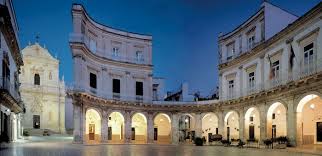
Martina Franca
Martina Franca is in the eastern hills of the Murge plateau, equidistant from the Ionian and Adriatic seas. Its name is derived in part from its devotion to Saint Martin, who saved the townspeople from enemy invasions. The town, one of the most densely populated in the Taranto province, is a melting pot of history and art.
Highlights of the historic centre include the characteristic white houses that wind their way up the small, twisting streets, and the sumptuous baroque architecture of the Ducal Palace, Palazzo Martucci, Palazzo Motolese, Palazzo Ancona and the important Basilica di San Martino.
Cisternino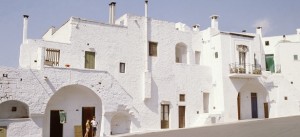
Facing onto the Itria Valley in an area known as the Murgia dei Trulli, Cisternino is 46 kilometres (28 miles) from Brindisi, near the Adriatic coast.
The Porta Grande (or Norman-Swabian) Tower , topped by a statue of San Nicola, is the main entrance to this, one of Italy’s Most Beautiful Towns.
Visit the old town centre and admire its many historical residences: the Governor’s Palace, a beautiful example of baroque architecture; the 16th century Bishop’s Palace;Palazzo Amati; Palazzo Lagravinese; and Palazzo Ricci-Capece with its Wind Tower.
A bit further on and you'll find the convent of Capuchin monks with the Church of Sant’Antonio, the Church of San Quirico, and the 16th century Chiesa Matrice (Mother Church), dedicated to San Nicola di Patara and constructed over the ruins of an earlier Paleo-Christian church.
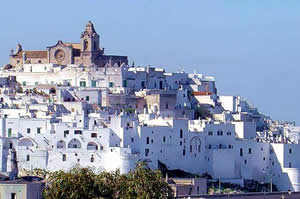
Ostuni
Ostuni, perched on three hills, is located inside the Itria Valley, 218 metres above sea level. It is 42 km away from Brindisi, 8 km away from the Adriatic coast and it was awarded the Blue Flag.
Ostuni, the White Town, is magic thanks to the characteristic whitewashed houses of its historic centre, a tradition the inhabitants still keep on. The fifteenth-century Romanesque-gothic Cathedral dominates in the middle of the hamlet, on whose façade the 24- rays rose window of rare beauty stands out.
A series of churches and elegant houses embellish the old town, surrounded by aragones walls where there are the two ancient entrance gates, Porta Nova and Porta San Demetrio.
Ostuni’s countryside is dotted with masserie (farmsteads), most of them changed into farmhouses for holiday (agriturismi) and luxury resorts.
Taranto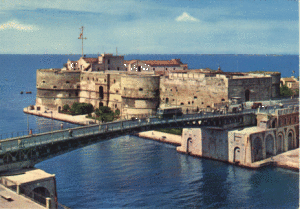
Taranto, known as "the city of two seas”, sits in a strategic position between the Mar Grande (Great Sea) and and the Mar Piccolo (Small Sea). This location has put it at the heart of important historical events.
The history of Taranto runs along the two bridges that connect the old city to the new part of town. There's a stone bridge, built after the flood of 1883, and then there's the ponte girevole (swing bridge), which opened in 1887. This latter, a marvel of mechanical engineering, leads straight into the maze of narrow alleyways that branch off the central Via Cava, itself lined with small craft shops.
Noble architecture and churches in various styles and from different periods stand on this isthmus of land. Notable examples include San Cataldo Cathedral with its combination of Romanesque and Baroque styles, and San Domenico Cathedral with its Gothic features.
Bari and adriatic coast
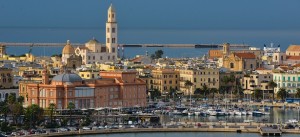 Bari
Bari
A captivating place to discover, Bari is a city of two facesits elegant Murat district and, stretching along the Adriatic Sea, the spellbinding area of Bari Vecchia (Old Bari).
Acting as a gateway to the old city, the grand Castello Svevo (Swabian Castle) , is crowned with fortified towers. Once used as defensive castle, it later became a Renaissance residence. The Arco del Pellegrino (Pilgrim’s Arch) leads through to the heart of the Cittadella Nicolaiana, and its Basilica a prized example of Puglia’s Romanesque architecture that's dedicated to San Nicola, Bari's patron saint.
Bari’s 19th century Murat district boasts many elegant palaces, such as the Teatro Petruzzelli, Teatro Piccinni and Palazzo Fizzarotti, while underground, you'll find hidden treasures rupestrian churches and hypogea dug into the rocks, such as the Temple of San Giorgio, the hypogeum of Madia Diana, and the “Jewish” hypogeum.
Puglia's regional capital, Bari plays a fundamental role in connection with other Mediterranean countries, thanks to the strategic role played by its port, airport, and international trade fair Fiera del Levante.
Polignano a Mare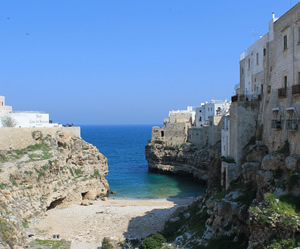
Crystal clear waters and cliffs pitted with caves carved by the sea give Polignano a Mare its uniqueness. A small town, known also as the “Pearl of the Adriatic”, it's just over 30 km (18.5 miles) from Bari.
Poligano is the birthplace of the renowned singer Domenico Modugno, who became famous for his song Nel blu dipinto di blu (“In the Sky, Painted Blue”). The fascinating historical centre reveals traces of its Arab, Byzantine, Spanish and Norman past, including the remains of the four watchtowers that once guarded the ancient town.
Head through the Arco della Porta (the Door Arch), once the town's only entrance, and you'll find yourself in the magical centre, home to the 13th-century Mother Church dedicated to the Assumption.
The high cliffs and jagged coastline between Palazzese Cave and Lama Monachile, make Polignano's shoreline one of Puglia's most beautiful coastal stretches, peppered with hidden inlets and charming sandy bays.
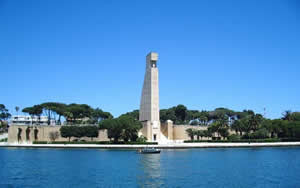 Brindisi
Brindisi
Brindisi faces the gentle waves of the Adriatic Sea, its natural port nestling into the mainland in the shape of a deer’s head.
Its long inner piers have been transformed into an elegant seafront, framing the old town, which today teems with pubs and restaurants. Visitors can immerse themselves in Brindisi's history going up the Scalinata di Virgilio (Virgil’s Staircase) with the two Roman columns at the top. Marking the end of the Appian Way, these pillars are the symbol of the city and have been a point of reference for sailors for a long time.
On Sant’Andrea Island in front of the port is the Forte a Mare (Castle of the Sea)an Aragonese castle made of red stone. The city's other large fortress is the Castello Svevo (Swabian Castle) , built by Frederick II as a fortified residence for his garrisons.
In the heart of the city, Piazza Duomo, boasts many attractions: the De Cateniano portico, the Provincial Archaeological Museum and the loggia of Palazzo Balsamo. Just a short distance away from here, the ancient Rione di San Pietro degli Schiavoni, houses the ruins of Roman Brindisi, including a paved street, the remains of several houses, and what's left of a thermal baths complex.
Salento
Lecce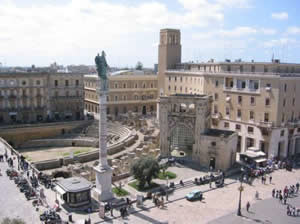
Called “the Florence of the South,” Lecce is the provincial capital of the Salento area, only 12 km (7.5 miles) away from the Adriatic Sea.
The common factor in the city’s characteristic baroque exuberance is the local “Lecce stone”, so soft and malleable, that master stonecutters were able to create highly sophisticated stone embroidery. The best example of this style is represented by the facade of the Basilica of Santa Croce and by the spectacular piazza Duomo home to a soaring bell tower, bishop’s palace, and the lovely Palazzo del Seminario.
Strength and majesty, however, characterize the Castle built by Charles V and designed by Gian Giacomo dell’Acaya. The Roman Amphitheatre, adjacent to the central piazza Sant’Oronzo offers an intriguing insight into the city’s history.
Gallipoli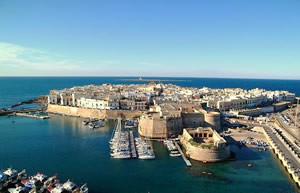
The seaside town of Gallipoli, whose name means Beautiful City, rests like a mirage on the Ionian coast, roughly 40 km (25 miles) from Lecce.
The old townperched on a limestone island, is connected to the new part of the town, on the mainland, by an arched bridge built in the 1900s. The walls, bastions, and towers, which originally defended the town from invaders, today protect it from rough seas, while also preserving the charm of days gone by.
Before exploring the narrow paved streets of the historic centre, from where you can catch an occasional glimpse of the sea, stop off at the authentic fish marketheld in what used to be the moat of the imposing Castle.
The old town seems to announce itself with the Greek Fountain, a monument which actually dates to the Renaissance and to which a baroque pediment was later added. Behind it, you can glimpse through the float trawlers to the Sanctuary of Santa Maria del Canneto and the Chapel of Santa Cristina, dedicated to the town's patron saint and the favourite saint of sailors.
Otranto![[1]](https://www.annesetour.it/wp-content/uploads/2015/08/otranto__dangelo_14150128233921-300x137.jpg)
Set on a rocky spur on Italy's most easterly coastline, Otranto is about 45km away from Lecce on the Salento peninsula's Adriatic coast.
Otranto's ancient city centre (“Borgo antico di Otranto”) has been recognized by UNESCO as “Culture of Peace Messenger Site”.
Begin your visit by walking along Lungomare degli Eroi (Heroes' Promenade), at the foot of the ancient city centre. Go past the monument dedicated to the Martyrs, sculpted by Antonio Bortone, and head down the stairs through the Porta Alfonsinato the old town. Take time to visit the Castello Aragonese (Aragon Castle) and the Cathedral, with its precious mosaic floor and the relics of 800 martyrs killed by the Turks in 1480.
Outside the town, you'll be charmed by a wonderful emerald green lake set amidst the coral-coloured hills of the Bauxite quarry, while the imposing Punta Palascìa lighthouse waits for the year's first dawn to break on Italy.
Porto Badisco, Aeneas' mythical landing point, harbours a series of wall paintings in the Grotta dei Cervi (Deer Cave), known as the “Neolithic Sistine Chapel”.
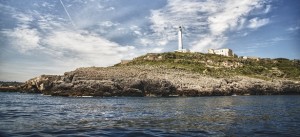 Santa Maria di Leuca
Santa Maria di Leuca
The Ionian and the Adriatic Sea meet in Santa Maria di Leuca, the southernmost part in Salento, enclosed by Punta Ristola and Punta Meliso, in the area of Castrignano del Capo.
The beautiful village of Leuca, whose name comes from the Greek “leucos”, white, can be admired from above and it displays its horizon dotted with white calcareous rocks. The lighthouse , 47 metres high, stands on Punta Meliso, and it is among the most important lighthouses in Italy, dominating the bay on which the village was built. Along the sea front, there is a series of elegant houses and liberty-style villas.
At the foot of the lighthouse, there is the Basilica of Santa Maria de Finibus Terrae, quaint historical place overlooking the sea.
The jagged coast of Leuca belongs to the Regional Nature Park Coast Otranto – Santa Maria di Leuca – Bosco di Tricase and is embellished with natural caves, reachable by sea. The local fishermen know every legend and the origins of these caves, which have curious names.

